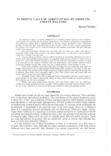Nutritive Value of Agricultural By-Products Used in Malaysia
Tropical agriculture research series : proceedings of a symposium on tropical agriculture researches
| ISSN | 03889386 |
|---|---|
| 書誌レコードID(総合目録DB) | AA00870529 |

本文フルテキスト
tars18-_109-117.pdf1.22 MB
An important aspect of animal production is to produce human food from the resources which cannot be used directly for human consumption. The effective utilization of agricultural by-products as animal feed is indispensable to develop animal production with a minimum amount of imported feed. Determination of the nutritive value of some tropical agricultural by-products was carried out by chemical analysis and feeding experiments and the following results were obtained.
1 Rice and by-products: Broken rice, rice bran, and rice straw are widely used and are important feeds. Crude fiber content of rice bran ranged from 4 to 33% due to the incomplete separation of husks from the bran.
2 Cassava and by-products: Cassava pellets are the most promising substitutes for com in animal feed when suitable protein sources are supplied. Crude protein content of cassava leaf is about 25%. Leaf meal could be utilized as feed. For the intensive utilization of cassava as feed it is necessary to use cassava varieties with low hydrocyanic acid content. Cassava starch extraction residues contain 80% water but only a small amount of this product is used.
3 Palm oil by-products: Press fiber and palm oil sludge are not commonly used. Palm oil sludge contains about 5% of solid material. Dried sludge which contains 7-31% fiber, 12-20% ash, 17-30% oil and 10% protein, holds a high potential as animal feed provided that the drying cost is lowered. Press fiber is not commonly used as feed. Palm kernel meal and Kopra cake are widely used as important local animal feeds.
4 Pineapple wastes: About 50% of pineapple fruit is discarded at the time of processing. A small amount of wet waste is used nearby farms. In many cases the high cost of drying restricts the extensive use of wet by-products.
5 Rubber seed meal, kapock meal, ipil-ipil, cocoa pod, borneo tallow nut, etc. which are produced in small quantities are also valuable. These products and their wet by-products which are not easily marketed as feed can be effectively. utilized in backyard farming systems.
1 Rice and by-products: Broken rice, rice bran, and rice straw are widely used and are important feeds. Crude fiber content of rice bran ranged from 4 to 33% due to the incomplete separation of husks from the bran.
2 Cassava and by-products: Cassava pellets are the most promising substitutes for com in animal feed when suitable protein sources are supplied. Crude protein content of cassava leaf is about 25%. Leaf meal could be utilized as feed. For the intensive utilization of cassava as feed it is necessary to use cassava varieties with low hydrocyanic acid content. Cassava starch extraction residues contain 80% water but only a small amount of this product is used.
3 Palm oil by-products: Press fiber and palm oil sludge are not commonly used. Palm oil sludge contains about 5% of solid material. Dried sludge which contains 7-31% fiber, 12-20% ash, 17-30% oil and 10% protein, holds a high potential as animal feed provided that the drying cost is lowered. Press fiber is not commonly used as feed. Palm kernel meal and Kopra cake are widely used as important local animal feeds.
4 Pineapple wastes: About 50% of pineapple fruit is discarded at the time of processing. A small amount of wet waste is used nearby farms. In many cases the high cost of drying restricts the extensive use of wet by-products.
5 Rubber seed meal, kapock meal, ipil-ipil, cocoa pod, borneo tallow nut, etc. which are produced in small quantities are also valuable. These products and their wet by-products which are not easily marketed as feed can be effectively. utilized in backyard farming systems.
| 刊行年月日 | |
|---|---|
| 作成者 | Kiyomi Kosaka |
| 公開者 | Japan International Research Center for Agricultural Sciences |
| 巻 | 18 |
| 開始ページ | 109 |
| 終了ページ | 117 |
| 言語 | eng |
